THE MARQUESAS EXPEDITION
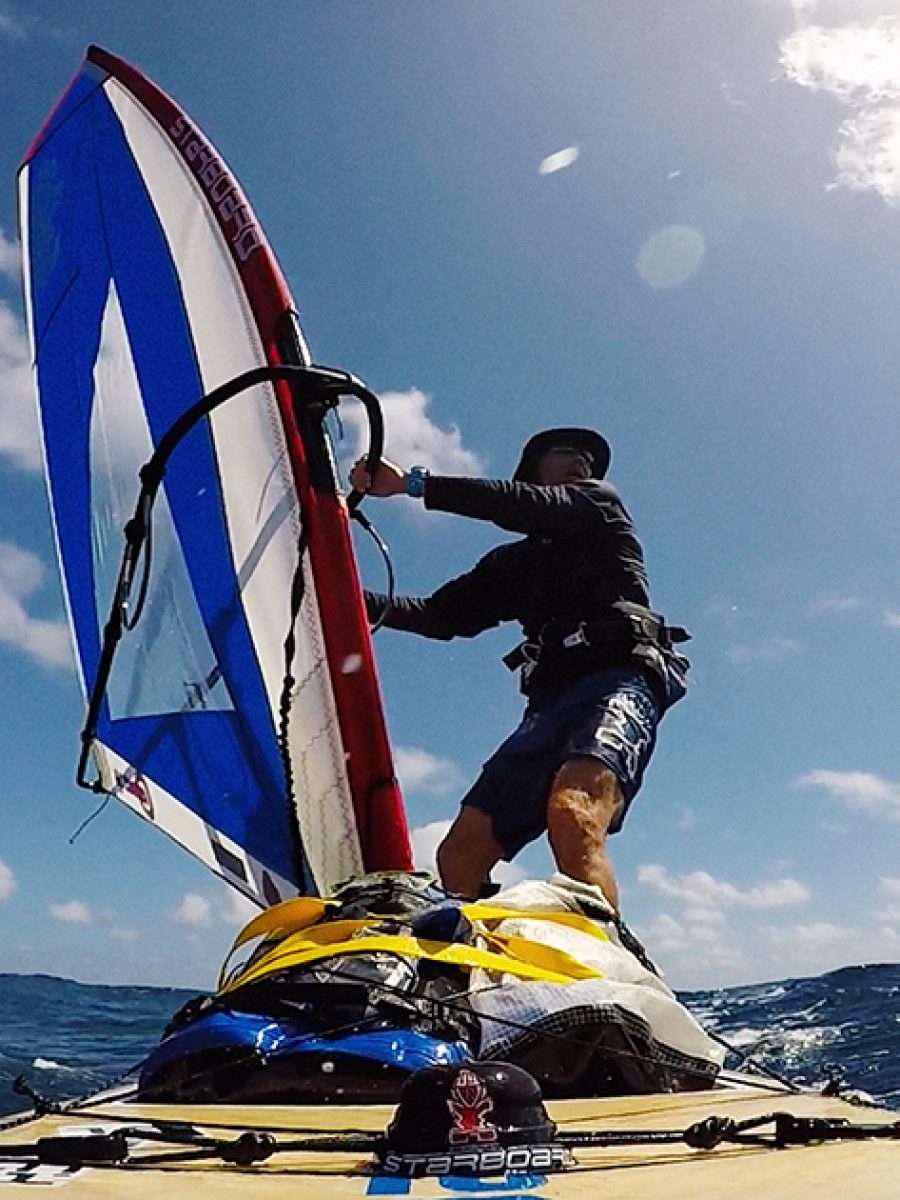
BART DE ZWART
Words & Photos Bart De Zwart
From windsurfing Jaws to record breaking long distance paddles on his SUP, Dutchman Bart De Zwart specialises in challenging conventional limits. Inspired by Thor Heyerdahl’s adventures in the Marquesas Islands, Bart travels between the islands by sail and paddle and takes us onboard as he recounts a memorable expedition.
This feature originally appeared in the August 2018 issue of Windsurf Magazine.
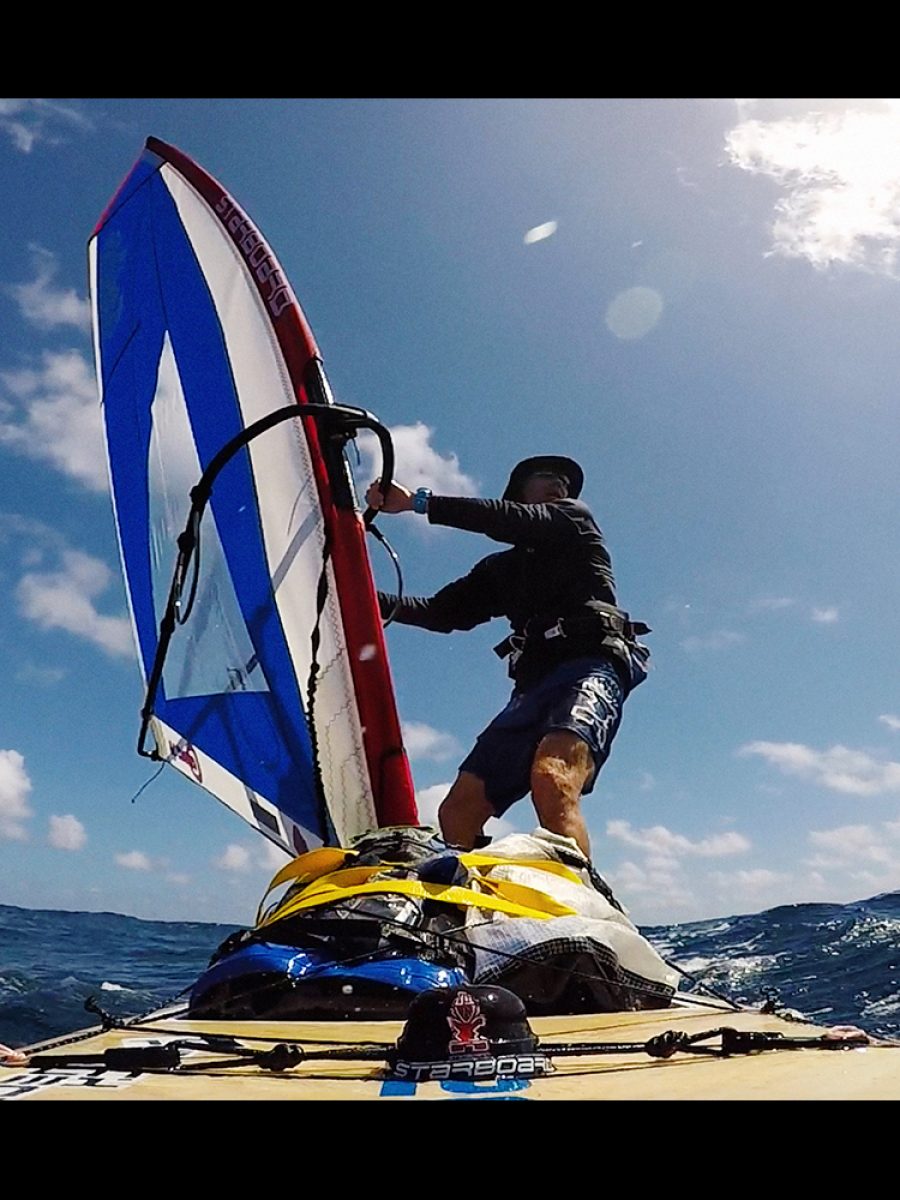
Many years ago, I read an inspiring book called “Fatu Hiva”, written by Thor Heyerdahl, also known for his daring journey on the ‘Kon-Tiki’ raft from South America to French Polynesia. The book describes the journey that a very young Thor and his wife Liz did in 1937. Thor wanted to spend a year ‘back into nature’, cut off from the world on the remotest islands he could find. After a lot of research in books and on maps, he found Fatu Hiva, the southernmost and most isolated island of the Marquesas Islands in French Polynesia, an overseas territory of France in the Pacific Ocean and the most isolated of the inhabited islands. Only a few months later he travelled all the way to this remote island group in the Pacific. It took them 6 weeks to get to Tahiti and he then waited a few months more to find a ship to Fatu Hiva.
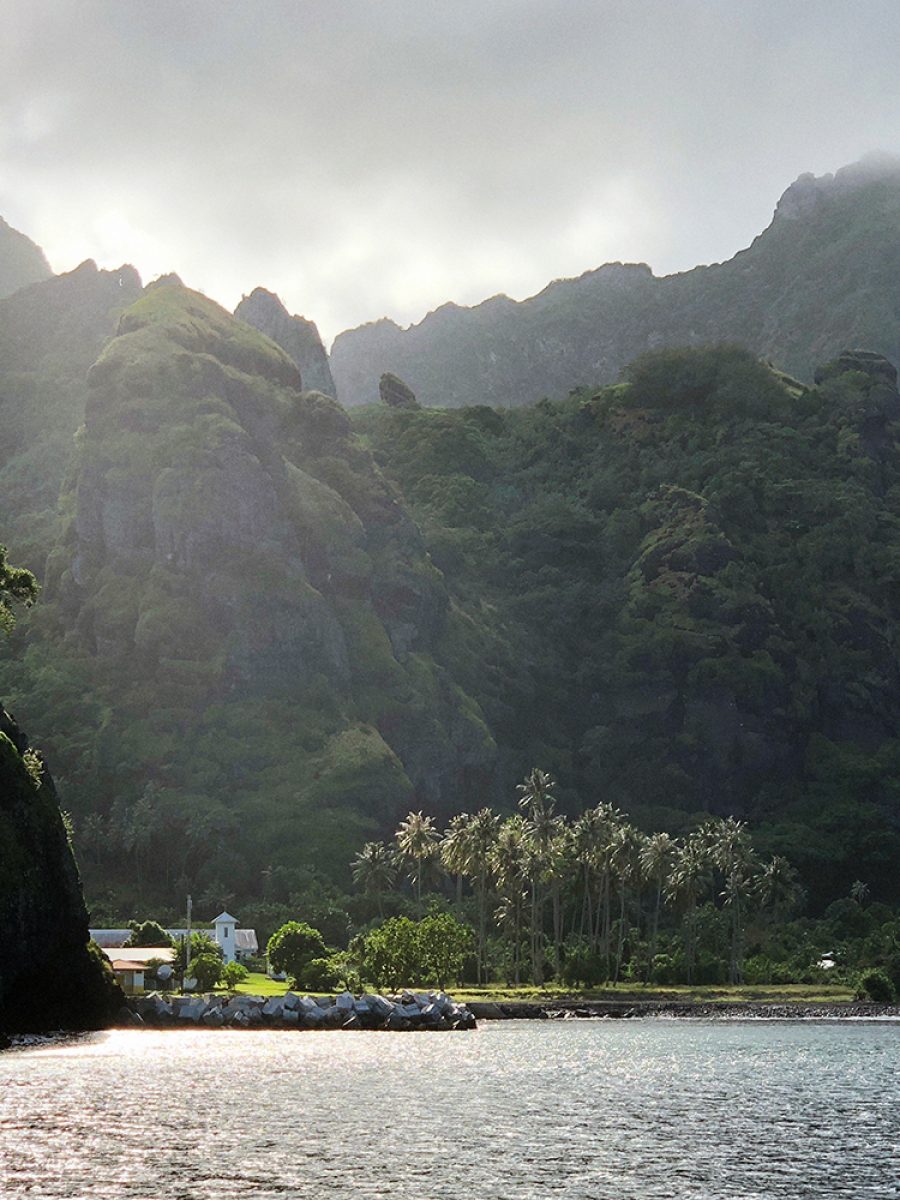
FATU HIVA
Now, more then 80 years later, I found myself on my way to Fatu Hiva to relive Thor’s journey, only this time on a 14’ stand up paddle board (Starboard Touring 14’ x 30”) which I could also windsurf. The wind is light and it is a hard upwind reach. If you miss the island it is more than a 1000 miles to Easter Island. Although I had water and food for 4 days, it was better I made sure I got to Fatu Hiva. I was hoping to reach it by nightfall, but I still couldn’t see the island on the horizon. My compass said I was on course and my GPS was telling me I was halfway, which was good, but it also told me I would arrive there in the middle of the night. Just when I thought the wind was totally giving up on me, I felt a fresh breeze from a slightly better angle. I had started in the early morning and paddled for 6 hours just to get around the eastern cape of Hiva Oa, the second largest island in the Marquesas Islands archipelago. I had arrived there the day before with a small propeller plane from Tahiti. Pifa, a super friendly local picked me up and drove me to Puamua on the other side of the island. Here you can find the largest and best preserved Tikis of French Polynesia. Tikis, statues carved in wood or stone, represent Ti’i, an ancestor – half human, half god, who according to legend was the first man. They are placed outside of houses to protect the inhabitants. It seemed only fitting to start my crossing to Fatu Hiva here.

AWARENESS
Another big reason why I wanted to do this expedition was to use it to raise awareness of the Thor Heyerdahl Climate Park in Myanmar. The park was started in 2012 by Arne Fjørtoft and the Ministry of Environmental Conservation and Forestry, Myanmar as a pilot project for large scale mangrove restoration worldwide based on three years research by WIF (Worldview International Foundation) in co-operation with Pathein University and Myeik University. Thor Heyerdahl was a founding member of WIF and the park was so named in his honour. Starboard (and mainly Svein Rasmussen, its owner) work very hard to make this world a better place by using eco-friendly materials, recycling materials and by offsetting the carbon footprint their business creates. They do this by planting mangroves in the Thor Heyerdahl Climate Park in Myanmar and these mangroves ‘carbon capture’ by absorbing CO2 in the air.
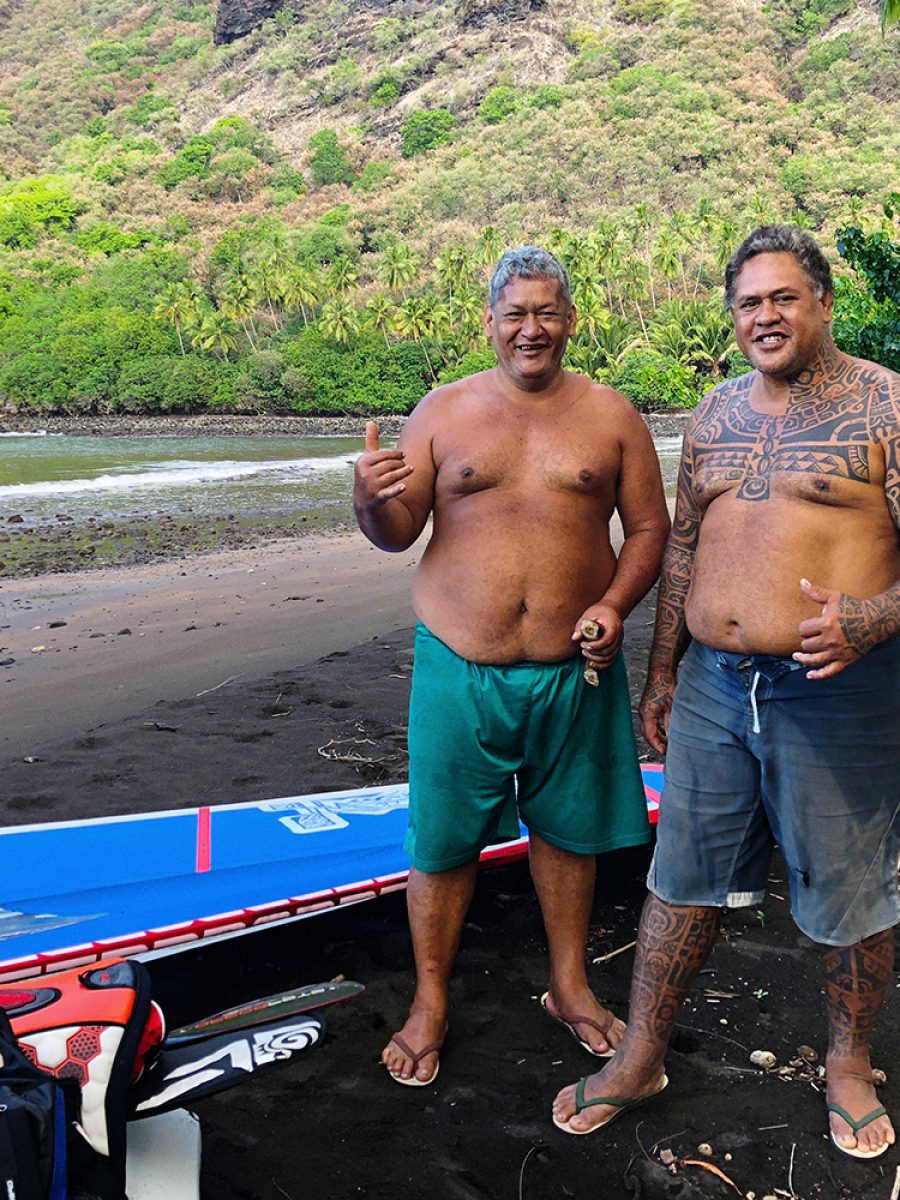
HANAVAVE
Now back to my crossing. It was 5:30 pm, the wind was picking up and I could point upwind enough to just make the island. I could now see the contours of Fatu Hiva, rising tall straight out of the ocean, but the sun was setting and without a moon I could barely see the island. Finally, at around 9 pm in the evening I got to the outer point of Fatu Hiva. I derigged my sail and paddled the last 2 hours to Hanavave, one of the most spectacular bays you will ever encounter. Tall green rock formations, in which you see many faces and tikis, form a narrow lush green valley where about 150 people live. Fatu Hiva is not as cut off as it was back in 1937, but the only regular way to get here is by boat, which only visits the island every two weeks. The inhabitants fish and grow fruits. The volcanic lands are very fertile and the tall mountains provide plenty of rain. I would only see the beauty of this bay the next morning, when I got there it was pitch dark, I could only see a few lights from the sailing boats who had just arrived from their long crossing across the Pacific Ocean from South America. The crew of one of the sailing boats is still awake because it turned out they had just arrived after 24 days at sea. Intrigued by my journey, they offer me somewhere to sleep on their boat, so I don’t have to find a spot for my tent on land in the middle of the night. Tired after my 17 hour crossing, I happily accept.
The next morning I paddle to shore and ask some of the locals where I can put up my tent.
After they find out I paddled and windsurfed here, the word goes around town and I get many interested visitors. The people here live next to the ocean and most of them fish every day, but at the same time they have a huge respect for the ocean and call me a sea warrior with a courageous heart. They feel sorry for me that I sleep on the beach in a tiny tent and offer me their houses and huts and come every night with food and water.
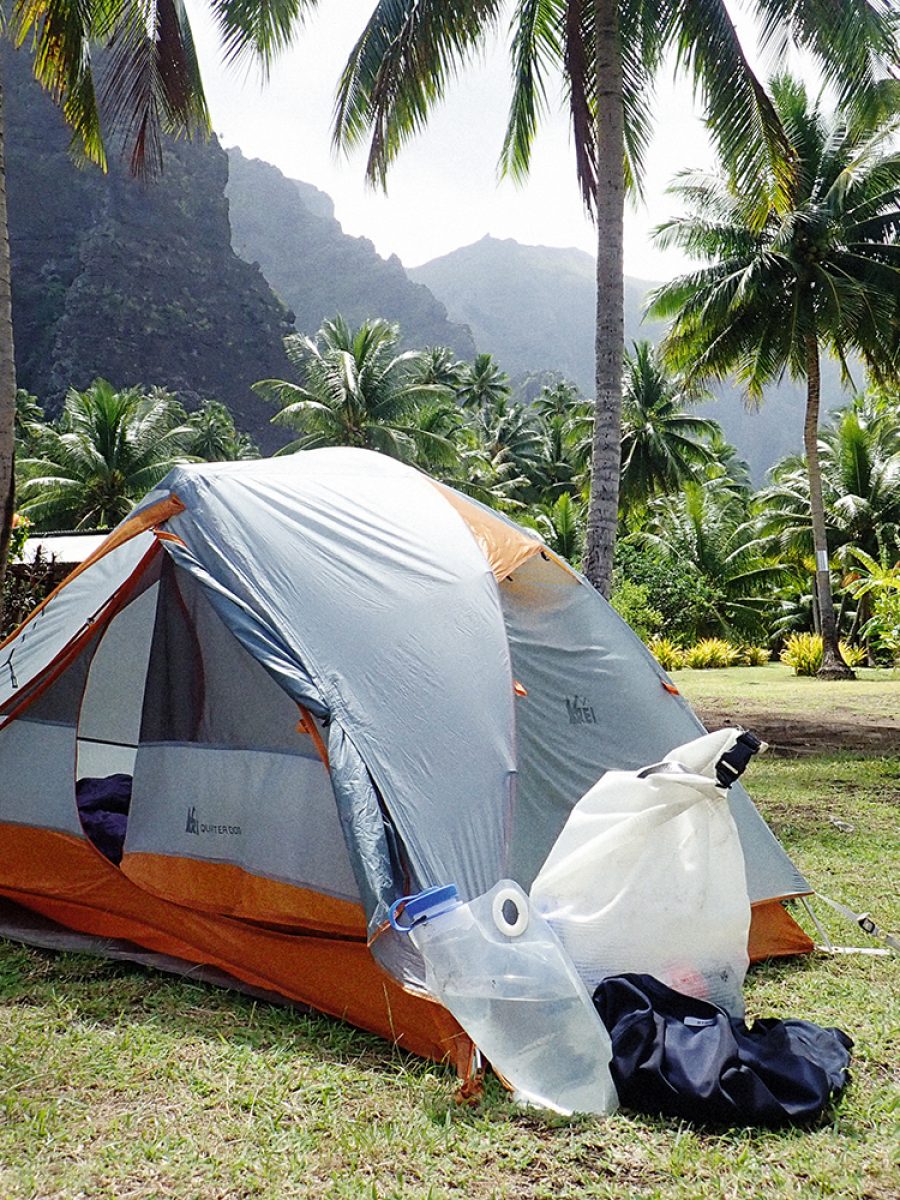
EXPLORATION
During my expeditions I have plenty of gear with me. Apart from the board, paddles and sailing rig, I bring waterproof bags with clothing, navigation equipment (2 x Compass, 2 x GPS, IPhone with navigation maps, satellite phone, satellite tracker and solar panel to charge cameras and navigation gear), tent, sleeping bag and camping mat, water and some food. The satellite tracker is a nice way for my family to keep track of where I am. Although sometimes it is a cause of worry when it doesn’t work or I forget to charge the batteries. My wife Dagmar wrote the following on Facebook while I was doing this crossing:
“A lot of you might have checked his tracker during the day and realized that it didn’t work. Actually, as I knew he would start in the morning, after 10 hours not seeing his tracker and knowing he would be out there on the ocean in an area which is part of the most remote in the South Pacific, I got really worried. Being married to this guy for almost 20 years I have learned to live by his mantra – “We worry when we have to worry”, which through the years, I must say, has rescued me from a lot of anxiety attacks I might have suffered while he was on one of his expeditions. So I tried to stay calm and tell myself if I don’t hear anything by the time it gets dark, I should start to worry. The time difference from here on Maui to the Marquesas is only +30 minutes. Finally at around 9 pm, 2 hours after dark, he calls and tells me that he is safe and close to the island. What a relief !!!!”
The next three days I spent exploring the island on foot, retracing the footsteps of Thor Heyerdahl on Fatu Hiva Island. I visit small roads in the valley and eat fresh papaya, juicy mangos and pomelos – a huge sweet and mild grapefruit with white thick flesh. I swim in the waterfall a few miles out of town. While I explore I also recover from the 16 hour crossing. By the second night the wind starts to blow hard and we get strong gusts through the valley. For me with a tent on land, no problem, but the sailing boats anchored in the bay have bigger problems. One after the other drags their anchor. I had given a bag with some of my electronics and valuables to Dick and Monique from the boat I had stayed on. They have a catamaran and try 4 times to re-anchor, after which they decide to leave the bay, but with my gear! Luckily they realize that and spend the night outside and return with my bag the next morning. Without my GPS, compass and some other essential items it would have been hard to do the crossing to the next island.
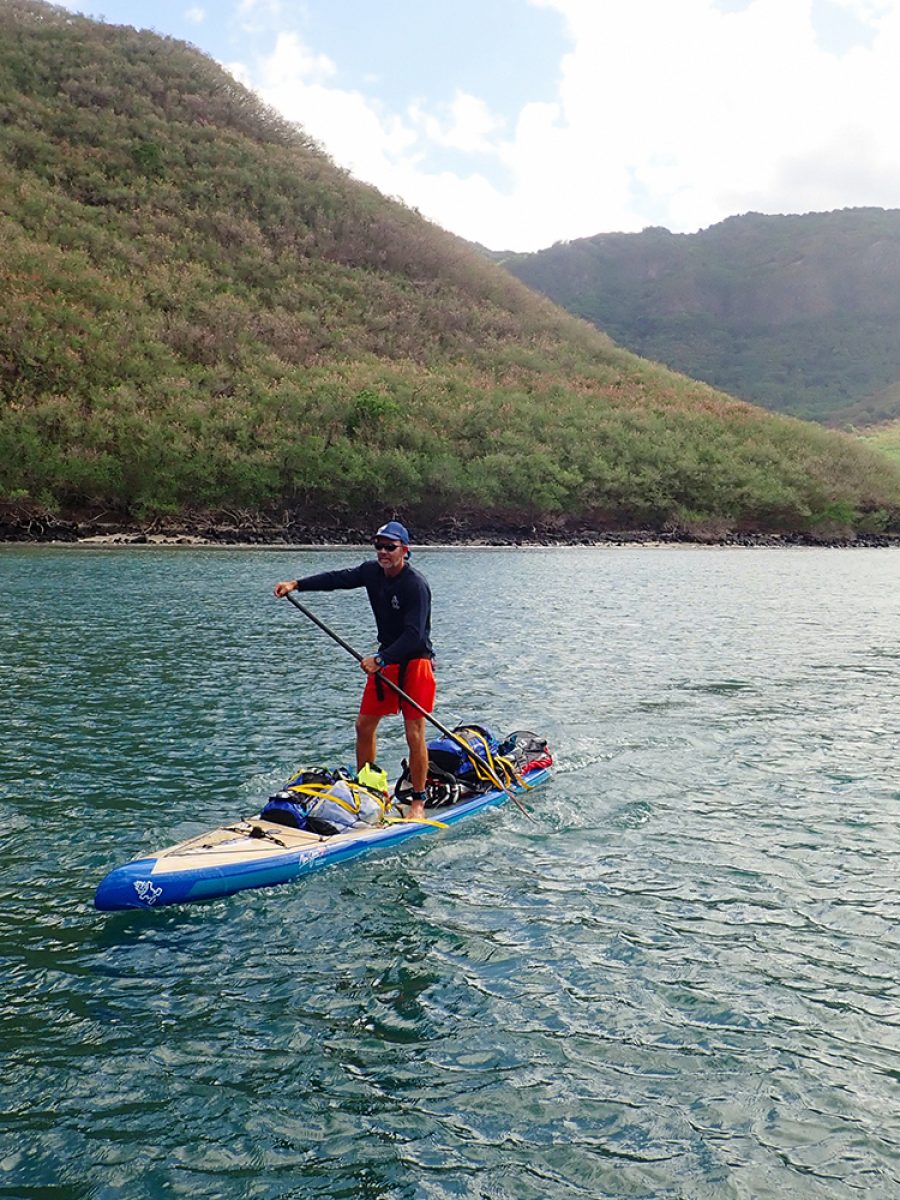
TAHUATA
On the third day on Fatu Hiva I wanted to hike to Ouia, one of the valleys where Thor Heyerdahl lived with his wife by himself for part of his stay on this remote island. An 8-hour hike across the mountains on a small single track is the only way to get there. Although it was eighty years ago, I feel the same excitement he must have felt. It is a beautiful hike through the forest and over steep mountain ridges to this pristine green valley that is still uninhabited. I did the hike barefoot / in cheap sandals, for which I paid the price with some blisters and sore muscles the next day when I leave Fatu Hiva and cross to Tahuata. I am sent off by many of the local friends I had made during the last 3 days. They look on with a combination of fear and excitement as I paddle off along the steep cliffs of Fatu Hiva. A couple of hours later, when I reach the northern point of the island, I rig my sail in the water and start the crossing to Fatu Hiva. I had picked a good day, as the previous days were dominated by very strong wind conditions, which makes everything a little harder. Today was perfect, 15 knots and from a good angle. After 12 hours I get to the island just before dark, but I still had a good two-hour paddle to the bay where I wanted to set up my tent.
I thought that windsurfing would be easier than the paddling. Let the wind and sail do its work you would think. But the reality is a little different. Rigging at sea is quite easy as long as you keep everything together and don’t lose any parts. Windsurfing a heavy packed board like this is different though. There is not much space for your feet, and because of the weight there is a lot of pull, so I mostly windsurf without using the harness. The swell also makes most reaches hard to be hooked in for. Especially downwind, when the board starts to surf down a wave while you constantly have to adjust the rig. The hardest thing, because you go only in one direction for many hours in the day, is that your neck hurts. So paddling is easier, but windsurfing is faster. On the longer crossings this makes a good difference in time. But it all costs a lot of energy and mostly when I get to the next island I am totally spent, tired and hungry.
So far no dolphins, whales or sharks are close by, only the occasional bird that checks me out. Making a few circles around me and leaving again, flying effortlessly between the waves.
At one point a Portugese man o’ war got between my toes and stung me many times before I got rid of him. I found a beautiful sandy beach with only some coconut trees on Tahuata. The following day I just relax and paddle over to the main village, the next bay over, to buy some food and do some sightseeing.
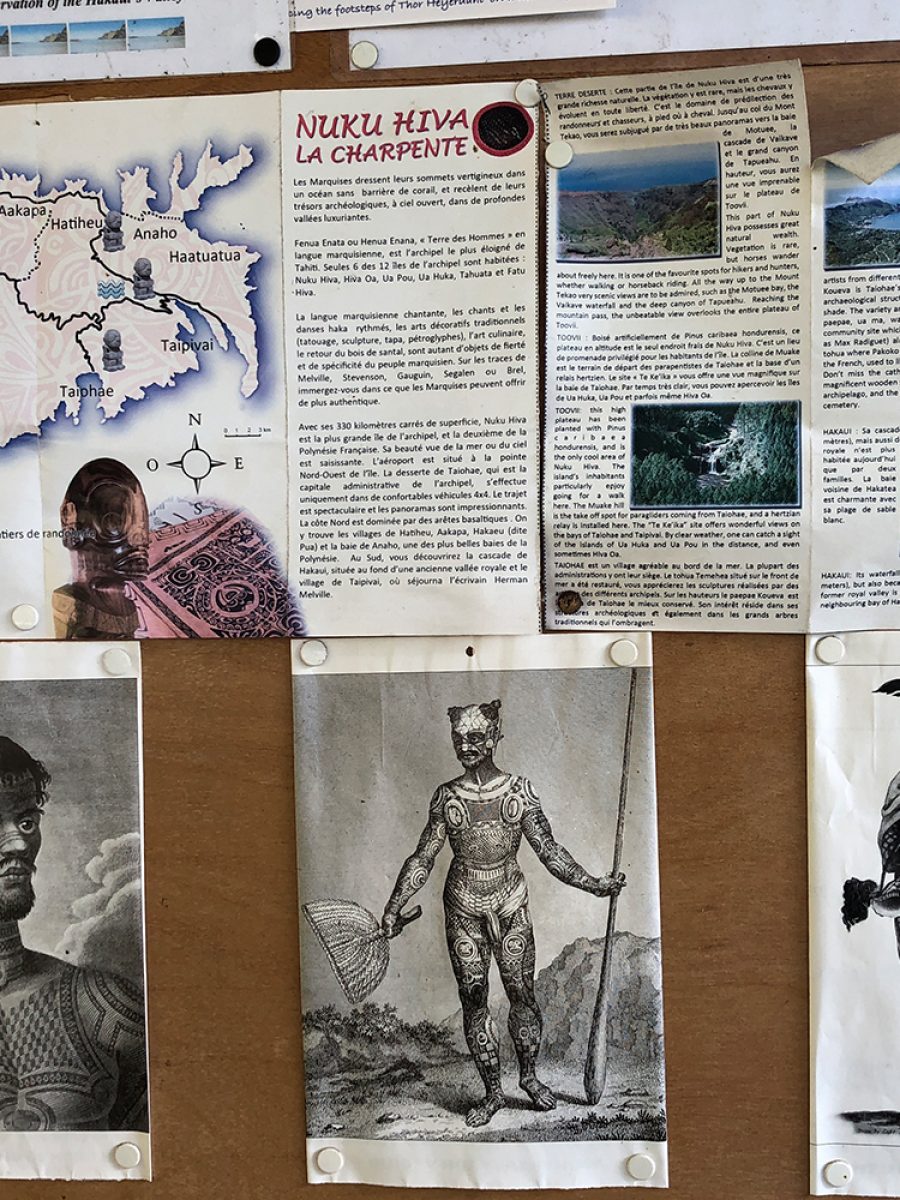
UA POU
My next leg to the island of Ua Pou is 70 nautical miles (130 kms), and the longest crossing of the expedition. I prepared everything the evening before, so I could have a running start at 2 am. I wanted to start in the middle of the night to arrive close to sunset in Ua Pou. For a few hours I slept onboard Dick and Monique’s boat with everything packed already in the water, they also fed me and we had a nice evening talking about boat life, which I’d last experienced about 10 years ago. Having everything ready to go and sleeping on the boat saved me a lot of time packing up the tent and tying all my gear onto the board.
At 2 am I started paddling in the rain with a light breeze on my back. It was pitch black, but soon after I was surprised by an amazing sky full of stars, which I used to keep course without having to look at my compass every few minutes. At one point the sky lit up and I saw one of the longest shootings stars I have ever seen. It is surprising how fast you get used to the movements of waves without being able to see anything in the dark. When the sun came up at 5:30 there was a good breeze, so I rigged up my windsurf sail. This wind lasted only for 10 minutes. Then it started to go down and down until there was nothing left. So I derigged everything and went back to paddling again for the next two hours. It looked like it was going to be a very long day and perhaps night…
But then suddenly the wind picked up and life was good again. My routine is paddle or windsurf for an hour and then take a 5 minute break to eat and drink something, check my position and course and if my tracker is functioning correctly. And so the hours go by. At sunset I was an hour away from the southern point of the island and 2 hours from my destination.
With the moon up this time I kept windsurfing. Windsurfing in the dark is not easy but this was made even harder with the waves bouncing back from the cliffs.
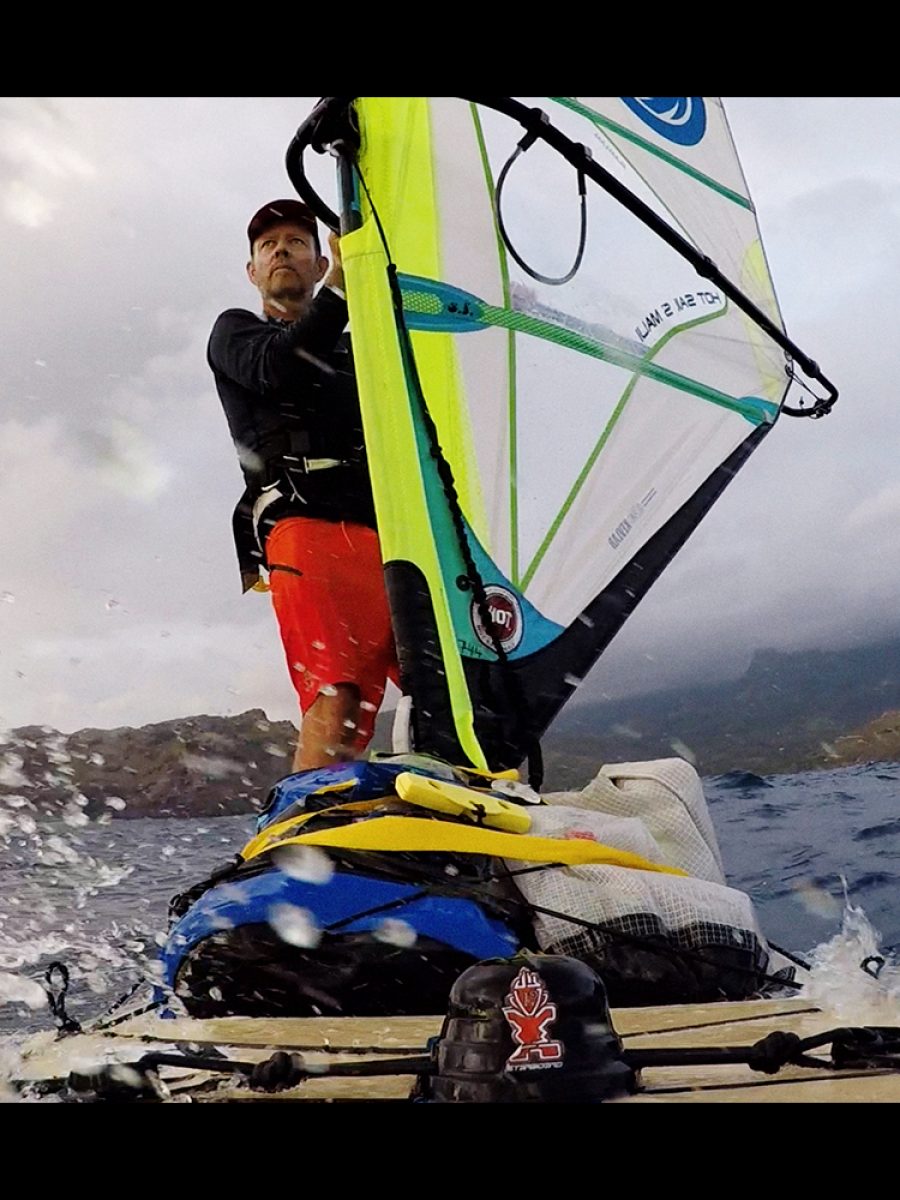
LANDFALL
It is always exciting to enter an unknown port or bay in the dark. Especially when it’s windy and waves are crashing on rocks nearby. I have very good nautical charts on my iPhone and could see where I was and the layout of the bay of Hakahau, but this one was special because you don’t see any lights of the village until you are almost past it. With waves on both sides hitting the rocks and a strong wind from behind, I made it in safely after 18 hours at sea, but I was totally exhausted. I was tired from being on edge for so many hours and was looking forward to a good sleep. But first I needed to find a good place to put up my tent. On the shore I asked a local who owned the Vaa (outrigger) school if it was ok to put up my tent on the beach next to his school. It took me a while to get my land legs back and I went to bed as soon as I blew up my mattress.
The next morning, I quickly made some new friends, Teaki and Joel from the outrigger school. They invited me over for coffee and eggs, a real treat in a place like this and especially after a crossing like the day before. They knew many Tahitian paddlers, so we even had some common friends.
Ten weeks a year, once a day, the schoolkids get outrigger paddling and swimming lessons here. I spoke to their teacher who said that the kids love it as much as he does. For him the world is still right in the Marquesas. Far away from all the crowds, chaos, wars and materialistic world, everybody here has time to talk or sit down at the beach and just watch the sun go down. Everyone I had met so far seemed genuinely happy, no matter what they owned.
Hakahau is the main town of Ua Pou, the third largest the Marquesas Islands. It is a quiet and sleepy island with dramatic peaks and mountain backdrops. Other then some sailing boats, not many visit this island, as indeed is the case for all the islands. I walked the town, talked to the locals and enjoyed the views, but mostly rested.
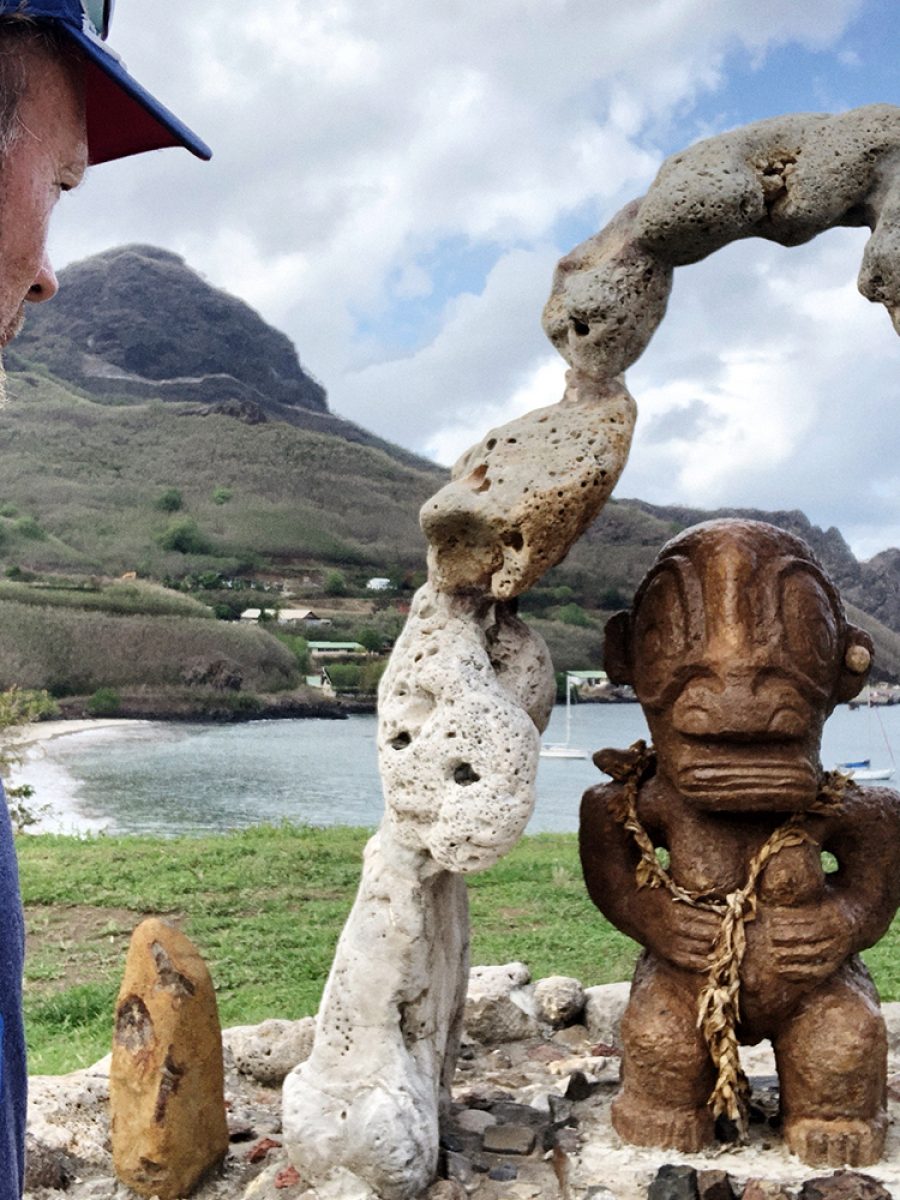
NUKU HIVA
After a dinner with Joel and Teaki between the outriggers in the school, I left the next morning to my last island, Nuku Hiva. I was afraid it was going to be a rough passage of many hours but it turned out to be a perfect and fast one. After less than 6 hours I came into the bay of Hakaui on Nuku Hiva. This is pure Marquesas. I entered the bay almost downwind with a heavy swell and waves breaking quite close nearby. Again an exciting entry, at least this time it was during the day. The further you come around the point the calmer it gets and then you enter a lush green valley with a distant waterfall in the background. I land my board on the black sand beach and walk over to a few locals who are working on their hut. Soon the two owners of the valley come over, interested to see what had just paddled into their bay. I ask permission to put up my tent for the night. In turn they had many questions about how I travelled and where I had been. It is funny throughout the islands they said that I had a ‘heart of courage’, but from my perspective they did too and that made me instantly bond with them. They offered me some huge mangos and pomelos, which I happily accepted.
In the afternoon I hiked to the waterfall in the back of the valley. More than 10.000 people used to live in this valley before the westerners came and brought illness and death. Now there are only 12 people left. The valley is full of fruit trees, palms and other green. One can understand people wanting to live in such a perfect valley, then and now. The waterfall didn’t have much water but it was still an impressive site. On the way back I ate with one of the locals who prepared food for a small boat with a few adventurous tourists who make the journey over from the main village everyday. After days on the water and living simply, it was great to have a real meal with green mango and guava salad, fried breadfruit and meat with fresh coconut water. A feast.
The next day my journey was coming to an end. I just had to battle the 6 miles against the 20-30 knots of head winds to get to the main village of Taiohae. That took a lot longer then expected, mostly because I had to turn back as I left my boom on the beach, which I only realized by the time I wanted to start windsurfing the last few miles. Another small disaster happened when a Portugese man o’ war got into my board shorts and started stinging where you don’t want it to sting! Fighting the wind for many hours, I finally came in at three in the afternoon just in time to arrange a car for the next morning to bring me to the other side of the island where the airport is located.
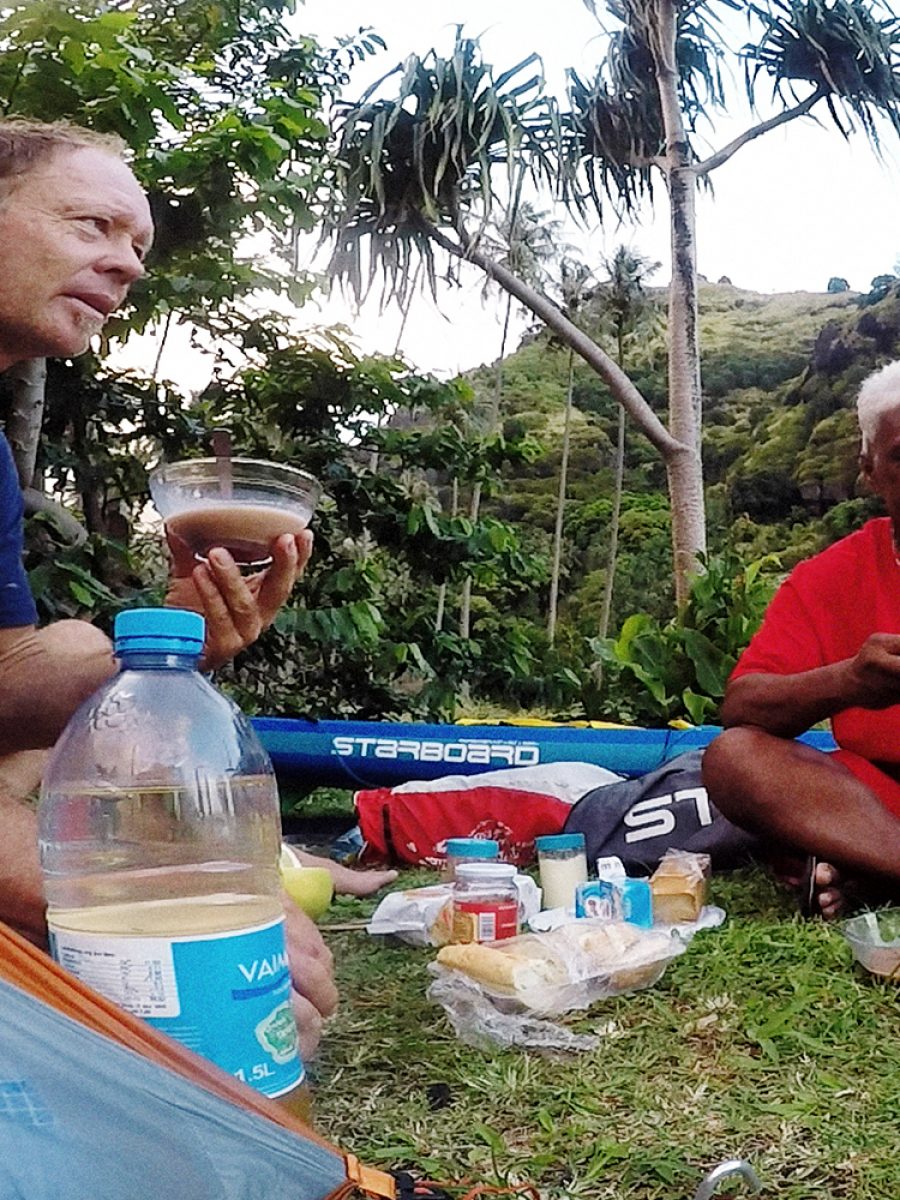
REFLECTIONS
Alexandre, owner of the valley where I just came from, also owns a house in Taiohae, the main village on Nuku Hiva. He offered me a place to sleep at his house so I could pack my gear up to get ready for the flight the next day. Again I happily accepted the true kindness of the Marquesian people. This is also what I take away from this expedition. While I sat in the 2-propeller plane back to Tahiti I had time to reflect. Yes, even one of the remotest places in the world has changed a little, more modern with cell phones and French bread, but what hasn’t changed were the people. It was good to see that you don’t need much to be happy; that the people around you and the place you live in makes you happy. Here people help one another and have a lot of time for each other. Something the modern world can learn from. The last 13 days flew by, the Marquesas and especially its people made a deep impression on me.
To make this story complete I visited the Thor Heyerdahl museum in Oslo. A great exhibition of all the journeys he made and things he achieved. The original Kon-Tiki and RA I and II rafts are both on display. I was lucky enough to meet Thor Heyerdahl Jr. there, now 80 years old but in many ways a son of his father, a nice man overflowing with knowledge and enjoyment of life. He has worked on many projects together with his dad and is still very involved with the museum. I think of Thor as an explorer but Thor Jr. explained to me he wanted to be seen as a scientist rather than the explorer. His wife Liz who joined him to Fatu Hiva was the adventurer and explorer.
This world is so special and there is so much more to explore.
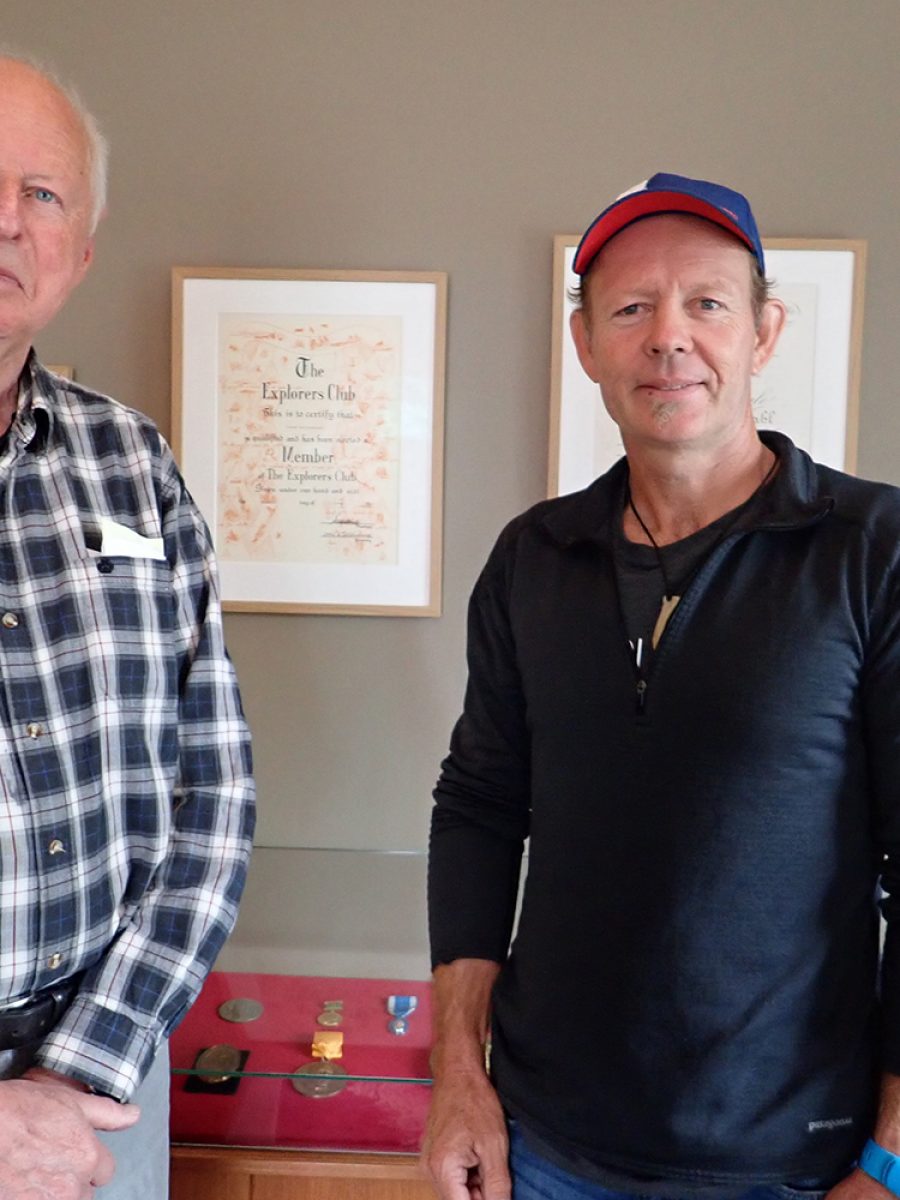
The post THE MARQUESAS EXPEDITION appeared first on Windsurf Magazine.